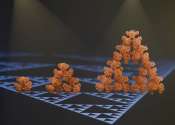Biggest X-ray laser in the world generates its first laser light
The European XFEL, the biggest X-ray laser in the world, has reached the last major milestone before the official opening in September. The 3.4 km long facility, most of which is located in underground tunnels, has generated ...







